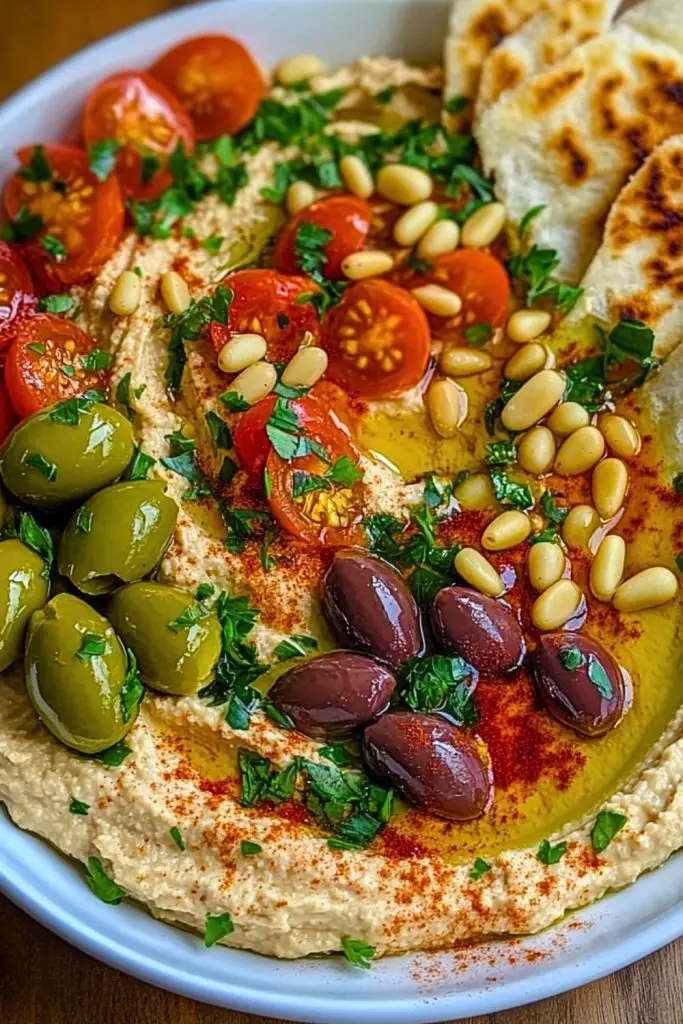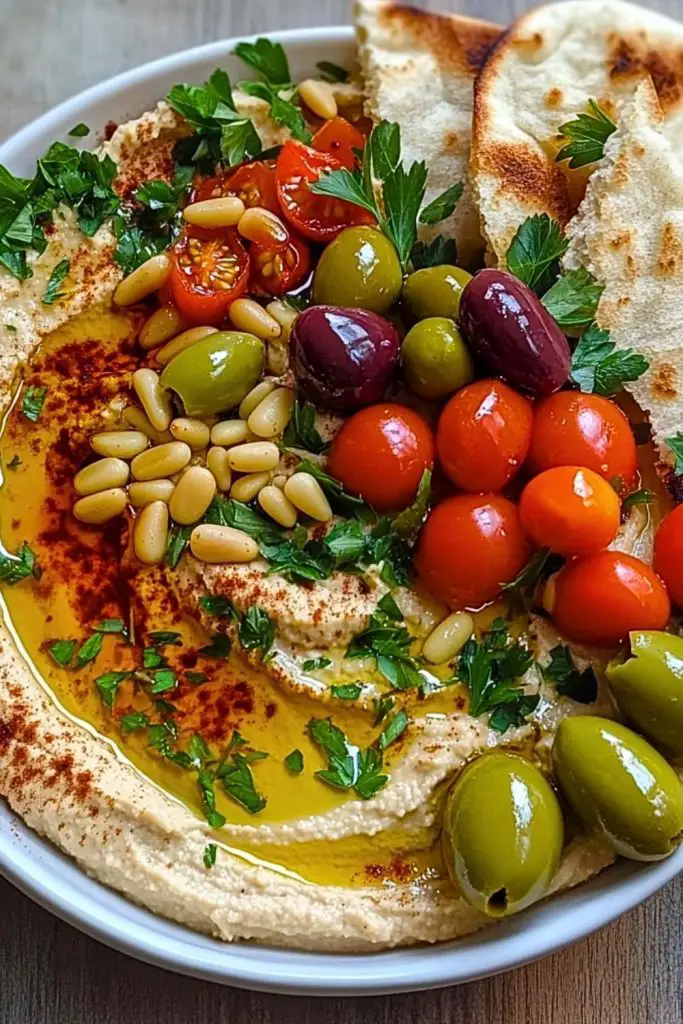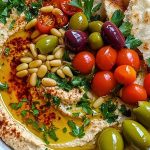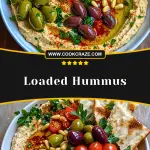When I want to serve something that feels both vibrant and comforting, I reach for this Loaded Hummus. It’s the kind of dish that brings people together—colorful, rich in texture, and bold in flavor. Whether I’m entertaining or just whipping up something satisfying for myself, this hummus delivers on every level.

What I especially love about this recipe is its versatility. A simple base of creamy hummus becomes a whole experience when topped with juicy cherry tomatoes, briny olives, toasted pine nuts, a drizzle of golden olive oil, and a pop of fresh herbs. It’s a feast for the eyes and the tastebuds. And when paired with warm, fluffy pita? Absolute heaven.
Why You’ll Love This Loaded Hummus
- It’s ridiculously easy. Most of the work is in assembling and layering the toppings.
- Visually stunning. This isn’t just food, it’s a centerpiece.
- Customizable to no end. Swap in your favorite toppings.
- Perfect for every occasion. A quick lunch, appetizer, or party platter.
What Kind of Hummus Should I Use?
The beauty of Loaded Hummus lies in how forgiving it is. You can absolutely use homemade hummus if you have the time—smooth, garlicky, and tahini-rich versions shine beautifully under all those toppings. But if you’re in a pinch, a good-quality store-bought hummus works just as well. I often reach for plain or classic hummus so the fresh toppings can shine. Just make sure it’s creamy and not overly thick; you want it to spread easily onto a plate.
Options for Substitutions
Whether you’re adapting to what’s in your pantry or catering to dietary preferences, there are plenty of ways to make this dish your own:
- Cherry Tomatoes → Roasted Red Peppers: Adds a sweet and smoky contrast.
- Green Olives → Kalamata Olives or Capers: For a saltier, brinier bite.
- Pine Nuts → Toasted Almond Slivers or Pumpkin Seeds: Still gives that crunch without sacrificing flavor.
- Parsley → Mint or Cilantro: Depending on your herb of choice, you can brighten or earth-up the flavor.
- Paprika → Za’atar or Sumac: A different spice profile, but still bold and fragrant.
- Pita Bread → Crackers, Lavash, or Fresh Veggies: Keeps it gluten-free or lighter.
These swaps ensure the hummus stays exciting and delicious no matter what you have on hand.
Ingredients for This Loaded Hummus
Each component plays a key role in building both flavor and texture, turning a humble dip into a loaded delight.
- Hummus: The creamy, savory base that holds everything together. Smooth and rich, it’s the canvas for all the toppings.
- Cherry Tomatoes: Their juiciness and natural sweetness contrast beautifully with the creaminess of the hummus.
- Green Olives: Add a punch of briny, salty flavor that cuts through the richness.
- Pine Nuts: Lightly toasted, they bring an irresistible crunch and a nutty aroma.
- Fresh Parsley: Adds freshness, color, and a gentle herby kick to balance the richness.
- Extra Virgin Olive Oil: A drizzle gives luscious mouthfeel and depth of flavor.
- Paprika: For a warm, smoky kick and that beautiful pop of color.
- Pita Bread: The perfect vehicle for scooping—soft, chewy, and just a bit crisp on the edges.
These ingredients come together to create something more than the sum of their parts—each bite is loaded with flavor and texture.

Step 1: Prepare the Base
Start by spreading a generous amount of hummus onto a large plate or shallow bowl. Use the back of a spoon to create a few swooping ridges or wells in the surface—these little grooves help cradle the toppings and olive oil.
Step 2: Slice and Arrange the Tomatoes
Halve your cherry tomatoes and scatter them over one side of the hummus. Their vibrant color and juicy texture bring instant life to the plate.
Step 3: Add the Olives
Place the green olives in the center or group them with the tomatoes for a Mediterranean cluster of flavor. If you prefer, slice them in half or leave them whole for more bite.
Step 4: Sprinkle the Pine Nuts
Toast the pine nuts lightly in a dry skillet over medium heat until golden and aromatic, then sprinkle them across the top. They add a welcome crunch and a buttery finish.
Step 5: Garnish With Parsley and Paprika
Finely chop the fresh parsley and scatter it liberally over the dish. Then, dust everything with a pinch of paprika—it adds warmth, spice, and visual appeal.
Step 6: Finish With Olive Oil
Drizzle good-quality extra virgin olive oil all over the hummus, letting it pool into the grooves and soak slightly into the toppings.
Step 7: Serve With Pita Bread
Warm your pita bread slightly and cut into triangles. Serve it alongside or tucked into the side of the plate, ready for scooping and dipping.
How Long to Cook the Loaded Hummus
Technically, there’s no cooking required—just a little toasting and warming. Here’s the timing breakdown:
- Toasting pine nuts: 2–3 minutes in a dry skillet until golden brown.
- Warming pita bread: 1–2 minutes in a skillet or toaster oven.
That’s it! The rest is simply assembly. From start to finish, this dish can come together in under 15 minutes, making it a go-to for quick entertaining or effortless meals.
Tips for Perfect Loaded Hummus
- Use room-temperature hummus. It spreads easier and tastes better than cold-from-the-fridge versions.
- Toast the pine nuts fresh. Pre-toasted nuts lose their flavor quickly—just a few minutes in a pan makes all the difference.
- Make it just before serving. The toppings look and taste their best when fresh.
- Don’t overdo the oil. A light drizzle is enough to enhance the flavor without making the dish greasy.
- Layer textures and colors. Cluster ingredients for visual appeal—group tomatoes in one area, olives in another, and sprinkle everything else over.
- Taste as you go. Especially if you’re using store-bought hummus—adjust the toppings to balance saltiness, tang, and richness.
With just a bit of attention, this simple dish turns into something truly special.
Watch Out for These Mistakes While Cooking
Even though Loaded Hummus is simple, a few missteps can dull its magic:
- Using cold hummus straight from the fridge: It’s harder to spread and the flavors are muted.
- Skipping the toasting step for pine nuts: You miss out on deep, nutty flavor that ties the whole dish together.
- Overloading with toppings: Balance is key—too many toppings can overpower the creamy base.
- Forgetting to season store-bought hummus: Sometimes it needs a pinch of salt, lemon juice, or garlic to wake it up.
- Not drying the olives or tomatoes: Excess moisture can make the hummus soggy over time.
- Using stale pita bread: Always warm it up or lightly toast to revive its soft texture and taste.
Avoid these and your hummus will be picture-perfect every time.
What to Serve With Loaded Hummus?
Grilled Chicken Skewers
A protein-packed pairing that soaks up the bold flavors of the hummus beautifully.
Cucumber and Feta Salad
Crisp, cool, and tangy—this salad offers a refreshing contrast.
Roasted Veggie Platter
Think zucchini, eggplant, and red peppers. Their caramelized edges are perfect for dipping.
Falafel Balls
Crispy on the outside, fluffy inside—an iconic match with hummus.
Herbed Couscous or Quinoa
A light, grainy base to complement the creamy hummus and juicy toppings.
Deviled Eggs or Jammy Soft-Boiled Eggs
They add richness and make the spread feel even more luxe.
Pickled Veggies
Their tangy bite cuts through the fattiness and adds sharp balance.
Crusty Bread or Flatbread
Beyond pita—something hearty to mop up every last bit.
Storage Instructions
Loaded Hummus is best served fresh, but you can absolutely prepare parts of it ahead and store leftovers smartly:
- Assembled and topped: Store in an airtight container in the fridge for up to 1 day. The toppings may release moisture over time, so expect slight softening.
- Base hummus only: If you’re prepping in stages, you can refrigerate the plain hummus up to 5 days before topping it.
- Toppings (separately): Slice the tomatoes, olives, and chop parsley ahead. Store each in separate containers to maintain freshness, and toast pine nuts just before serving.
- To refresh: Stir the hummus to smooth it, blot extra moisture from toppings, then reassemble with a fresh drizzle of olive oil and herbs.
Avoid freezing—the texture of hummus and toppings suffers significantly.
Estimated Nutrition
Here’s a rough estimate for one serving (assuming 6 servings total from one platter):
- Calories: ~280 kcal
- Protein: 7–8g
- Carbohydrates: 18–22g
- Fat: 20–22g
- Fiber: 5–6g
- Sugars: ~3g
- Sodium: ~400–500mg
Nutrition will vary depending on the brand of hummus, amount of toppings, and type of bread served with it. If you’re tracking closely, plug your exact ingredients into a nutrition calculator for more accuracy.
Frequently Asked Questions
Can I make Loaded Hummus ahead of time?
Yes, you can prepare the hummus and toppings separately ahead of time, but assemble just before serving to keep everything fresh and vibrant.
Is it okay to use store-bought hummus?
Absolutely. A high-quality store-bought hummus saves time and still tastes delicious. Feel free to enhance it with a little lemon juice, garlic, or tahini if needed.
Can I use other nuts instead of pine nuts?
Yes! Toasted almonds, walnuts, or pumpkin seeds work well and add similar crunch with a slightly different flavor.
What if I don’t have fresh herbs?
Dried herbs like oregano or za’atar can be used, but fresh parsley, mint, or cilantro really elevate the brightness and flavor.
Is this recipe gluten-free?
It can be! The hummus and toppings are naturally gluten-free—just serve with gluten-free crackers or veggies instead of pita bread.
How do I keep the toppings from making the hummus watery?
Make sure tomatoes and olives are drained well and patted dry before layering. Add juicy toppings right before serving.
Can I make this spicy?
Definitely! Add chili flakes, a drizzle of hot sauce, or top with sliced jalapeños for a heat kick.
Can I double the recipe for a party?
Yes, and it’s a great idea. Use a larger platter and double all ingredients. Guests will love scooping their way through a party-sized version.
Conclusion
Loaded Hummus is one of those dishes that makes you wonder why you ever served plain hummus on its own. It’s fast, flexible, and full of life—bringing together vibrant colors, bold flavors, and irresistible textures in one show-stopping spread. Whether it’s for a cozy snack or the centerpiece of your next gathering, this recipe promises to deliver satisfaction with every scoop.

Loaded Hummus
- Total Time: 13 minutes
- Yield: 4-6 servings
Description
Loaded Hummus is a vibrant, crowd-pleasing platter of creamy hummus topped with juicy cherry tomatoes, briny olives, toasted pine nuts, fresh herbs, and a drizzle of olive oil. Perfect for entertaining or elevating a simple meal.
Ingredients
- 1 1/2 cups hummus (store-bought or homemade)
- 1/2 cup cherry tomatoes, halved
- 1/3 cup green olives (whole or sliced)
- 2 tablespoons pine nuts, toasted
- 2 tablespoons fresh parsley, chopped
- 2 tablespoons extra virgin olive oil
- 1/2 teaspoon paprika
- Warm pita bread, for serving
Instructions
- Spread the hummus onto a large plate, using the back of a spoon to create swirls.
- Scatter halved cherry tomatoes over one side of the hummus.
- Add green olives in the center or grouped with the tomatoes.
- Toast pine nuts in a dry skillet for 2–3 minutes until golden, then sprinkle on top.
- Garnish with chopped parsley and dust with paprika.
- Drizzle the olive oil over the entire dish.
- Serve immediately with warm pita bread.
- Prep Time: 10 minutes
- Cook Time: 3 minutes

